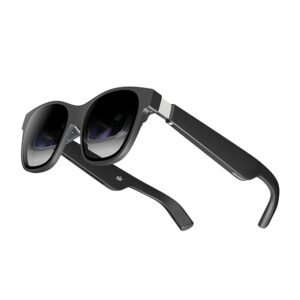Augmented Reality Glasses. Advantages & Disadvantages
Augmented Reality Glasses:
Augmented Reality (AR) glasses are wearable devices that overlay digital information onto the user’s view of the real world. They provide an immersive experience by blending virtual elements with the user’s physical environment in real-time. These glasses typically consist of display screens, sensors, cameras, processors, and connectivity options.
 The concept of AR glasses could change how we use tech and see the world. They bring new chances for better tech, work, and fun. Here’s a brief timeline:
The concept of AR glasses could change how we use tech and see the world. They bring new chances for better tech, work, and fun. Here’s a brief timeline:
- 1968:Ivan Sutherland’s “Sword of Damocles” is among the earliest AR devices, head-mounted displays in the realm of virtual reality.
- 1990: Research and development in the field of AR continue, with various prototypes and experiments.
- 2013: Google unveils Google Glass, a wearable AR device aimed at consumers. Google Glass faces privacy concerns and limited functionality, leading to its discontinuation in its original form
- 2016: Microsoft launches HoloLens, a mixed reality headset that blends virtual and physical worlds. HoloLens is primarily targeted at developers and enterprise applications.
- 2020s: AR glasses continue to evolve with advancements in display technology, sensors, and processing power. Companies like Apple, Facebook, and numerous startups are investing heavily in AR glasses development.
-
2021: Facebook (now Meta) collaborated with Luxottica to introduce Ray-Ban Stories, smart glasses focusing on social media integration and music playback with a camera. This marked an attempt to introduce AR in a familiar form factor.
-
2023: Meta released the Quest 3, a VR headset with improved performance and user experience, blurring the lines between VR and AR and showcasing the potential for future mixed reality devices.
Advantage & Disadvantage Augmented Reality (AR) glasses.
Advantage:
- Enhanced User Experience.
- Hands-free interaction.
- Real-time information.
- Applications across industries
- Remote Assistance.
Disadvantages:
- High cost
- Limited battery life
- Privacy Concerns
- Social acceptance:
- Technical limitations
Future of Augmented Reality Glasses:
The future of AR glasses holds promise for continued innovation and adoption. Key developments may include:

- Advancements in Display Technology: Future AR glasses may feature improved display technologies with wider field of view, higher resolution, and better outdoor visibility.
- Miniaturization and Ergonomics: AR glasses are expected to become more lightweight, compact, and comfortable to wear for extended periods.
- Enhanced Connectivity: AR glasses will likely feature enhanced connectivity options, enabling seamless integration with other devices and cloud-based services.
- AI and Machine Learning Integration: AI-powered algorithms will enhance AR glasses’ capabilities for object recognition, scene understanding, and personalized content delivery.
AR glasses could change how we use tech and see the world. They bring new chances for better tech, work, and fun.
Augmented Reality Glasses Risk for Health.
- Eye Strain: Extended use of AR glasses can lead to eye strain, headaches, and blurred vision.
- Impact on Mental Wellbeing: The constant visual stimuli might disrupt sleep patterns and contribute to anxiety or attention deficit issues.















Post Comment